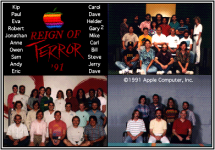Interesting observations! So maybe we just have to integrate it...however, the weird "every 15" bytes still have to play into the equation somewhere...
The uncompressed LC III startup sound (which is the same sound the Quadra 700 makes at startup according to Mactracker) is 31,178 bytes. The compressed sounds in the Quadra 700 ROM are 20,985 bytes and 16,440 bytes.
No idea which one is which, but assuming it's the first (longer) one, it's looking like a compression ratio of about 3:2. I suppose someone with a Quadra 700 could put the smaller sound in place of the bigger one. If a different sound plays, we'd know what the smaller one sounds like...if the same sound plays, we'd know the second smaller sound is the Q700's startup chime and then we could figure out a way to play the bigger sound to find out what it contains. I believe my ROM SIMM is compatible with the Quadra 700...
It's possible that in the Quadra 630 ROM they just left a bunch of old code that happened to include the older compressed version of the same sound. I already know they leave a lot of backwards-compatible code in their ROMs -- for example, if I boot a IIci with the Quadra 700 ROM, it plays the IIci's synthesized startup sound (and boots OK). True, it would still be kind of strange to leave both the compressed and uncompressed versions in the ROM though, considering they could just patch the code to use the uncompressed version anyway (the sound player code they include would automatically handle everything correctly if they just pointed to the uncompressed sound header).
The uncompressed LC III startup sound (which is the same sound the Quadra 700 makes at startup according to Mactracker) is 31,178 bytes. The compressed sounds in the Quadra 700 ROM are 20,985 bytes and 16,440 bytes.
No idea which one is which, but assuming it's the first (longer) one, it's looking like a compression ratio of about 3:2. I suppose someone with a Quadra 700 could put the smaller sound in place of the bigger one. If a different sound plays, we'd know what the smaller one sounds like...if the same sound plays, we'd know the second smaller sound is the Q700's startup chime and then we could figure out a way to play the bigger sound to find out what it contains. I believe my ROM SIMM is compatible with the Quadra 700...
It's possible that in the Quadra 630 ROM they just left a bunch of old code that happened to include the older compressed version of the same sound. I already know they leave a lot of backwards-compatible code in their ROMs -- for example, if I boot a IIci with the Quadra 700 ROM, it plays the IIci's synthesized startup sound (and boots OK). True, it would still be kind of strange to leave both the compressed and uncompressed versions in the ROM though, considering they could just patch the code to use the uncompressed version anyway (the sound player code they include would automatically handle everything correctly if they just pointed to the uncompressed sound header).


